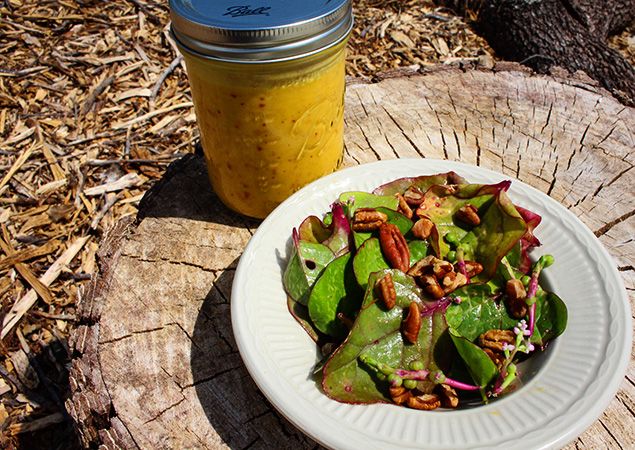It just takes one step outside to be reminded that the full-fledged summer heat has finally arrived in Austin! These sweaty temperatures make the cucumbers, melons, and tomatoes filling up harvest baskets a refreshing and welcome treat, but are you missing garden-fresh salad greens? Malabar spinach may be the summer green you’re looking for.
Malabar spinach, known by a number of other names such as Ceylon spinach, red vine spinach, and climbing spinach, is a delicious and super nutritious vegetable that thrives in hot weather. Native to tropical regions of Asia, this beautiful vining plant is not a “true” spinach but bears this common name because it has a similar flavor. It also shares a similar nutritional profile, containing high levels of vitamins A and C (in fact, more vitamin C than true spinach), as well as calcium, iron, potassium, manganese and magnesium. Malabar spinach leaves are succulent and a bit slimy in a way similar to okra. Some people find this texture delightful, and others distasteful, but in any case, the mucilage that causes the sliminess also makes Malabar spinach rich in soluble fiber and a helpful aid for digestion. Both green-stemmed and red-stemmed varieties (particularly red-stemmed) are high in carotenoid pigment antioxidants, including beta carotene. Throughout tropical Asia and on the Indian subcontinent, the leaves and shoots of Malabar spinach are eaten raw and in stir fries, curries, and soups.
With a bit of special care, Malabar spinach will thrive even when planted in July. Start Malabar spinach from seed, from a cutting, or from transplant as early as mid-March, after the last frost. To plant from seed, sow seeds one inch deep in well-drained soil, one to two feet apart. Sprouts will emerge after 2-3 weeks. Transplants can be planted using the same spacing. Malabar spinach should be planted along a fence or trellis. It is an impressively fast climber, and it needs support or it will grow into a disorderly mess. As a tropical plant, Malabar spinach requires consistent moisture, so water deeply and keep the soil around your plants covered with a 2-inch layer of mulch to minimize evaporation. Planting Malabar spinach in partial shade will also help keep moisture levels consistent, and will cause the plant to produce larger and more succulent leaves. In one warm-weather season, a Malabar spinach plant can climb 10 to 20 feet high, so harvest abundantly!
Malabar spinach will not tolerate frost, so in our climate it is an annual, but it produces copious numbers of seeds so you will likely find volunteer plants the following spring (if these are not desired, pull them up when they are young). This prolific vegetable suffers from few pest problems, except for susceptibility to root knot nematodes and a fungus that can eat holes in the leaves. Prevent the former problem by rotating this crop with corn or amaranth, and address the latter by removing all affected leaves.
Harvest tender, young leaves and shoots (the growing tips of the vine) using scissors or clippers (the flowers are edible too!). For that seasonal green summer salad you were yearning for, toss some Malabar spinach with pecans and homemade vinaigrette. Making homemade vinaigrette only costs pennies and a few minutes, so once you start making your own, you will probably find that you like it better than store-bought versions. The most important part of a vinaigrette are its two basic counterparts—oil and vinegar. The ratio should be three parts oil to one part vinegar (feel free to adjust slightly depending on the combination and your taste, but this is the basic formula). As far as what types of oil or vinegar—it really is up to what you like. If you enjoy the taste of olive oil, you might opt for extra virgin oil with a fresh, grassy taste or even a smoked olive oil. Feel free to experiment with grapeseed, pecan, or even avocado oil. Of course regular canola or vegetable oil will be fine too in a pinch. For vinegars, the most basic vinegars are plain white vinegar or apple cider vinegar. Feel free to use others that you may enjoy as well—red or white wine vinegar, rice vinegar (very mild) or balsamic. You may also want to use some lemon, lime or orange juice in place of the vinegar for a more refreshing taste. To make your vinaigrette even more summery, try adding seasonal fruit, like we have done in this recipe!

